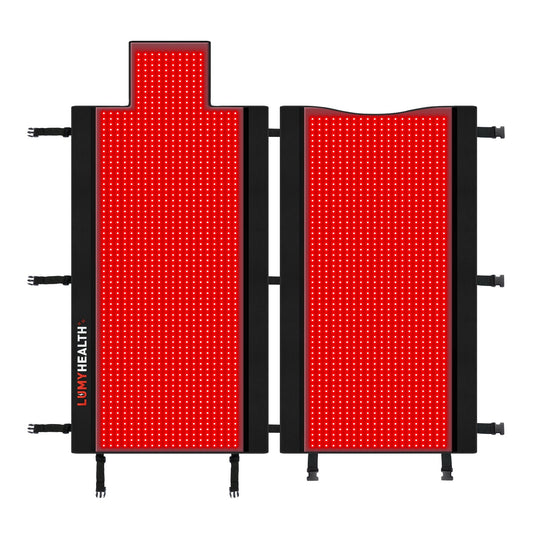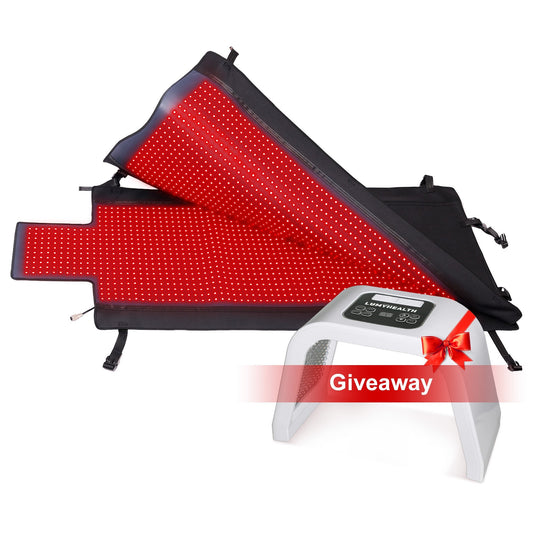
Let’s face it—choosing the perfect red light therapy device can feel like trying to pick the best movie on a streaming platform: overwhelming and full of options. From panels and mats to handheld gadgets, every device promises glowing skin, pain relief, and better wellness. But how do you know which one is actually worth it?
That’s where I come in. In this guide, I’ll break down everything you need to know about red light therapy devices. I’ll explain how red light therapy works, the benefits you can expect, and why factors like wavelengths and power output are crucial when making your choice. We’ll also dive into the differences between portable and stationary devices, how to spot safe and high-quality options, and whether a higher price tag really guarantees better results.
By the end of this post, you’ll know exactly what to look for in a red light therapy device, no matter if your goal is radiant skin, pain relief, or a general wellness boost. Let’s get glowing!
1. What is Red Light Therapy and How Does It Work?
Red light therapy uses low-wavelength red and near-infrared light to penetrate deep into the skin and tissues. The light stimulates the mitochondria in your cells—the powerhouse of your cells—which boosts energy production. This increased energy helps cells function better and repair more efficiently. Specifically, it encourages the production of adenosine triphosphate (ATP), which fuels cellular activity.
When used on the skin, red light therapy enhances collagen and elastin production, leading to improved skin tone, texture, and elasticity. For muscle and joint issues, the therapy helps reduce inflammation, improve blood flow, and promote faster healing. Essentially, it speeds up the body’s natural recovery process by giving your cells the energy they need to perform at their best.
The light penetrates different depths of tissue based on its wavelength—630-660 nm targets the skin's surface, while 810-850 nm goes deeper to address muscle and joint pain. Regular use of red light therapy can reduce pain, accelerate healing, and improve overall skin health without the need for invasive treatments or medications.
2. The Key Benefits of Red Light Therapy for Skin, Pain, and Wellness
Let’s dive into why red light therapy is making waves in the world of health and beauty. First up: skin benefits. If fine lines, wrinkles, or acne scars are driving you nuts, red light therapy could be your secret weapon. It stimulates collagen production, which helps plump up the skin and smooth out those annoying imperfections. Plus, it can even out skin tone, reduce redness, and give you that natural glow you’ve been craving.
Now, let’s talk about pain relief. Whether you’re dealing with sore muscles after a workout, joint stiffness from arthritis, or chronic pain, red light therapy works wonders. It penetrates deep into your tissues, promoting blood flow and reducing inflammation. It’s like a deep-tissue massage—but without the awkward small talk.
Finally, there’s overall wellness. Red light therapy isn’t just about looking good; it’s about feeling good, too. Struggling to fall asleep? It can help regulate your circadian rhythm, making it easier to get those Z’s. Feeling drained? Red light therapy boosts cellular energy, which can leave you feeling more energized and ready to tackle the day.
In short, red light therapy is like having your own all-in-one health tool. Whether you’re targeting skin concerns, looking for pain relief, or just want to boost your overall well-being, this is one investment that truly pays off.
These benefits aren’t just claims—they’re supported by research. A study published in the Journal of Clinical and Aesthetic Dermatology found significant improvements in skin elasticity and smoothness.

For products designed to support your wellness journey, visit my red light therapy product page.
| Benefit Category | Specific Benefits | How It Works | Ideal Wavelengths | Scientific Support |
|---|---|---|---|---|
| Skin Health | - Reduces fine lines and wrinkles - Fades acne scars - Boosts collagen production - Improves skin tone and texture |
Stimulates fibroblast activity to enhance collagen and elastin production while improving circulation in the skin. | 630-660 nm | Study: Improves skin elasticity, cited in the Journal of Clinical and Aesthetic Dermatology. |
| Pain Relief | - Eases joint stiffness - Reduces muscle soreness - Soothes chronic pain and inflammation |
Increases blood flow and reduces inflammation by enhancing cellular repair processes in muscles and joints. | 810-850 nm | Supported by research on arthritis and muscle recovery in Pain Research and Management. |
| Sleep and Energy | - Improves sleep quality - Boosts energy levels - Balances circadian rhythm |
Enhances mitochondrial function, which increases ATP production for cellular energy and regulates natural sleep cycles. | 630-850 nm | Studies show improved energy levels and sleep cycles with consistent use (Frontiers in Neurology). |
| Overall Wellness | - Speeds recovery post-workout - Reduces inflammation - Enhances mood and mental clarity |
Promotes tissue repair, reduces oxidative stress, and stimulates the release of endorphins and serotonin. | 660-850 nm | Evidence cited in multiple studies on inflammation reduction and mental health benefits (BMC Sports Science). |
Notes:
- Wavelengths: 630-660 nm targets the skin, while 810-850 nm penetrates deeper for muscles and joints.
- Usage: Benefits can be seen with 10-20 minutes of daily use, depending on the device.
3. Different Types of Red Light Therapy Devices: Panels, Mats, and More
Not all devices are created equal. The right one depends on your goals and lifestyle.
- Panels: Best for full-body treatments. Ideal for those looking to target multiple areas.
- Mats: Great for lying down and relaxing while treating the back or whole body.
- Handheld Devices: Perfect for targeted areas like the face or hands. Portable and easy to use.
Here’s a comparison chart:
| Device Type | Best For | Portability | Price Range |
|---|---|---|---|
| Panels | Full-body care | Low | $100-$2000 |
| Mats | Relaxation | Moderate | $100-$1000 |
| Handhelds | Targeted areas | High | $100-$500 |
4. Wavelengths and Power Output: What to Look for in a Red Light Therapy Device
Red light therapy isn’t a “one-size-fits-all” approach. Wavelengths and power output matter.
- Wavelengths: Look for devices offering 630-660 nm (red light) and 810-850 nm (near-infrared light). These ranges penetrate deeply into the skin and muscles.
- Power Output: Measured in mW/cm². A good device provides at least 100 mW/cm² for effective results.
Think of it like sunscreen—you wouldn’t pick the lowest SPF and expect full protection. The same logic applies here.
Check product specs carefully before buying.
5. Portable vs. Stationary: Which Red Light Therapy Device is Right for Your Lifestyle?
Your choice depends on how and where you’ll use it.
- Portable Devices: Lightweight, compact, and easy for travel. Great for people with busy lifestyles.
- Stationary Devices: Bulkier but more powerful. Ideal for dedicated home setups.
If you’re always on the go, a handheld option might suit you. But if you want a spa-like experience at home, panels or mats make more sense.
6. How to Evaluate the Safety and Quality of Red Light Therapy Products
Safety should always come first. Here’s how to ensure you’re buying a reliable product:
-
Certifications: Look for FDA-cleared or CE-certified devices.

- Material Quality: Durable build and non-toxic materials.
- Warranty: A strong warranty shows the brand stands by its product.
Avoid generic or unbranded devices. Stick to trusted names. Sites like FDA.gov can provide more information on safety standards.
7. Comparing Price Points: Is an Expensive Red Light Therapy Device Worth It?
You get what you pay for—but not always. Here’s a breakdown:
- Budget-Friendly Options: Ideal for beginners or light usage.
- Mid-Range Devices: Offer better durability and features.
- High-End Devices: Provide advanced technology and longer lifespans.
Don’t overspend if you’re new to red light therapy. Start small, then upgrade as needed.
8. How to Choose a Device Based on Your Specific Wellness Goals
Your goals should guide your choice:
- For Skin Care: Look for handheld devices with red light wavelengths (630-660 nm).
- For Pain Relief: Opt for panels or mats with near-infrared light (810-850 nm).
- For General Wellness: A full-body panel works best.
Remember, the more targeted your goal, the more specific your device should be.
9. Tips for Using Red Light Therapy at Home for Maximum Results
Once you’ve chosen a device, follow these tips for success:
- Consistency: Use your device 3-5 times a week for best results.
- Placement: Keep it 6-12 inches away from your skin unless instructed otherwise.
- Session Time: Start with 10 minutes and increase gradually.
- Protect Your Eyes: Use goggles if your device doesn’t have built-in safety features.
Choosing the perfect red light therapy device doesn’t have to be overwhelming. By understanding the key factors—like wavelengths, power output, and device types—you can confidently find a solution tailored to your needs. Whether you’re after glowing skin, pain relief, or an overall wellness boost, the right device can make all the difference.
Investing in your health is one of the best decisions you can make. So, take the time to evaluate your options, read reviews, and consider what works best for your lifestyle. Your journey to a healthier, happier you begins now!
Don’t wait to feel better and look your best. Browse our top picks for red light therapy devices now and find the perfect fit for your needs!" For an easy setup guide, visit my red light therapy how-to work.





























